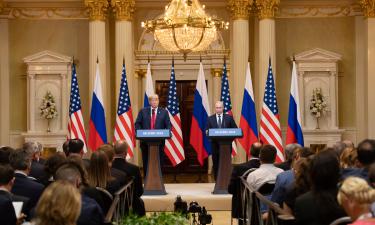Russian professor says swine help in transplantation of human hearts
Russian scientist Mikhail Razgulov invented a unique method for transplanting human organs. A two-headed dog that the scientist demonstrated to the world was once called the most disgusting wonder. And now the professor is going to surprise his colleagues. Mikhail Razgulov says it is possible to revive organs of deceased humans for transplanting to living people. It is amazing that the scientist suggests that a swine is to be used as a depository of a revived organ. The first results of such experiments conducted these days are really stunning!

Mikhail Razgulov, a transplantology surgeon aged about seventy and known worldwide lives on the outskirts of the city of Podolsk in the Moscow Region. Medicine colleagues speak of Razgulov as of an absolutely talented but rather conflict man. Mikhai Razgulov calls himself the only disciple of Professor Demikhov. The professor worked at Russia’s leading transplantology institutions for over forty years. He is a pensioner now but still studies science and practices medicine.
The whole of the world heard the sensational news that a dog operated by Demikhov lived for about five months with a transplanted extra heart. The achievement was as amazing as launching of the first Earth satellite. Christian Barnard, the first transplantologist in the world who successfully transplanted a human heart also came to the Russian genius Demikhov as a trainee. Mikhail Razgulov regrets that his teacher was never allowed to transplant a human heart. And it was until Demikhov’s death that he was considered a charlatan in his country. But he was the first surgeon who successfully transplanted a dog head. After transplantation the dog lived for several weeks but the fact was never made public. Later, Razgulov repeated this and other operations that his teacher had performed earlier. Razgulov also transplanted a cardiopulmonary complex. The unique operation gathered a delegation of doctors even from abroad. The operated dog was put stitches on and then awakened from anaesthesia. The frenzied dog tore strings around it and even attempted to bite an aid-man.
The desk of Professor Razgulov is piled up with lots of shiny metal items. He demonstrates one device and explains that the thing resembling pincers can suture even thin-walled veins. In his other hand there are two latex tubules pinned together with a stapler. He says that the device helped him make operations on veins last three times shorter. The thing could have saved hundreds of human lives if introduced in the official medicine. The professor cannot understand why all suggestions on solution of the donor organs deficit are carefully hushed up.
It is known that the deficit of donor human organs is one of the key problems in the modern transplantology in Russia and worldwide. Scientists say that any organ in the human organism and even the heart can be transplanted, and a man can live for long with a new organ. But it is a great problem where organs necessary for transplantation can be obtained. Human cloning is suggested as one of the ways for the problem solution. But Professor Razgulov says that organs meant for transplantation can be made of a human’s own tissue. For the time being, the professor says he is working on making kidneys of mice soft tissues for further transplantation to them. Many of the experimental animals wake up when the operation is over. Razgulov hopes the discovery will once again become a sensation worldwide. This experiment means that people will not have to wait for years till a donor organ appears.
But the suggested method is just a half measure. The professor says that organs of deceased people can be revived and used as donor organs. The idea was suggested many years ago by Demikhov but was absolutely ignored as it contradicted the official medical line.
Today, surgeons in many countries are allowed to take organs of people whose brain is already dead but other parts are still living and use them for transplanting to other people. It is generally believed that death of the human brain means his death. But there are just few donors of this type, and sometimes organs cannot be used for transplanting because of the tissue incompatibility. Besides, relatives often strongly protest against taking organs of their close people whose brains are dead but the hearts are still beating. These people still believe that their relatives can be saved.
In the 1960s, professors from Moscow and Kiev disputed about the period of time within which the human brain dies after the heart activity is stopped. A Russian professor stated that the human brain dies in 5-7 minutes after the heart stops. If blood circulation is not restored in the body within the period it means its biological death. His opponent from Kiev, Doctor Vladimir Yankovsky insisted that the brain could be revived evenan hour after the blood circulation stopped. And it was decided to confirm the statement with an experiment. A dog was drowned in a hot laboratory bath. In 26 minutes, Doctor Yankovsky and his colleagues began to reanimate it and the animal began to move. The doctors from Kiev applied the traditional external cardiac massage, artificial ventilation of lungs and inter-arterial blood pumping. But Mikhail Razgulov witnessed the experiment and says that he saw the doctors inject something into the dog’s carotid artery during the reanimation. As it turned out later, the Kiev doctors had patented the medicine abroad and were keeping it absolutely secret. They just told Razgulov that brain cells do not die within 5-7 minutes but only stop to function. The problem is that within this period of time oxidase generation stops and no oxygen is delivered to tissues. In other words, human brain gets no nutritive material. The injection given to the experimental dog was an artificially synthesized oxidase. In a day, the dog could not be distinguished from any healthy one. Professor Yankovsky stated that it was possible to reanimate living creatures even after a longer period since their death. The Kiev doctors conducted the same experiment on a dog in 45 minutes after its death. The miraculous injection was patented but Mikhail Razgulov says he has never since that time heard of it and Professor Yankovsky.
In 1946, Vladimir Demikhov did the first transplantation of a donor heart together with lungs from one dog to another. Within the several next years he also performed transplantation of almost all important organs. In 1962, he transplanted a heart to a dog. Contrary to forecasts, the dog survived after the operation. Demikhov was the first surgeon who transplanted a dog’s head.
It was already in the 1960s that Vladimir Demikhov said that doctors would always experience the shortage of donor organs. He suggested that organs taken from dead patients in a morgue could be revived for further transplantation.
Mikhail Razgulov tells about such experiments. Organs taken from stiffen dead bodies were rinsed, put into transparent thermostat containers and attached to the swine vessels with the help of transparent pipes on the animal’s neck or leg. And hearts taken from dead people thus began to contract and restored their normal function in several hours. Experiments conducted by Demikhov showed that hearts taken from dead patients in 1-2 or maximum 4.5 hours after their biological death could be revived. When such a heart restores its function, a cardiogram and biopsy must be taken of it for a thorough study. And then after cooling this heart can be delivered to a hospital for further transplantation to patients. It is possible to attach up to five containers with organs to each swine. And for better contact of tissues, a swine’s blood can be previously replaced with the human cadaveric blood. The only problem in this case is how to make a swine motionless for the period of an operation. Anaesthesia given to an animal is enough for 12 hours at maximum. Mikhail Razgulov offers to put organs that were not used within a short period of time into polyurethane packs and then transplant them into a swine’s abdominal cavity or under its skin on the neck. Such a swine with transplanted human organs can live its normal life and keep the organs until they are required for an operation.
Academician of Rosselkhozakademia Lev Ernst welcomes the idea suggested by Demikhov and Razgulov on using the swine as a bank of organs. He says that if the experiment is a success it is going to become one of the greatest achievements of the century. However, it is too early to speak about such a bank of organs as a ready solution for transplantology. The academician gave two pigs to Professor Razgulov for the experiment and now is looking forward to the experiment results.
Why do the scientists choose the swine? For his experiments, Professor Demikhov used dogs, monkeys and swine after previously replacing their blood with human cadaveric blood. Only the swine survived after it which means it is the closest to humans as concerning histocompatibility. Demikhov had not enough time to answer if a revived donor heart would contract inside of a recipient body. And Mikhail Razgulov gave such an answer. He conducted several experiments on transplanting a cadaveric cardiopneumatic complex taken off a patient in two hours after his death and then revived. He transplanted it to dogs. He says that there is no great difference between transplantation of a living organ or a revived cadaveric one. It is particularly important to correctly determine the period of absolute restoration of the heart function. Does it mean that the shortage of donor organs could have been solved fifty years ago?
Moskovsky Komsomolets
Translated by Maria Gousseva
Pravda.ru
Subscribe to Pravda.Ru Telegram channel, Facebook, RSS!





